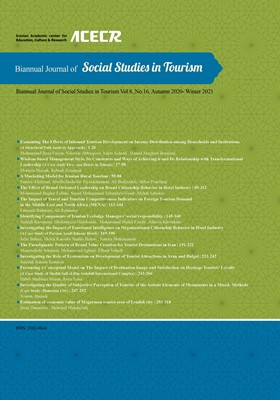The Impact of Travel and Tourism Competitiveness Indicators on Foreign Tourism Demand in the Middle East and North Africa (MENA)
Subject Areas :Fatemeh Rahmani 1 , Ali Rahnama 2 *
1 -
2 -
Keywords: MENA countries#tourism demand#competitiveness#Data Panel Pattern,
Abstract :
Today, the role of the tourism industry has been accepted as a category in creating fields of interaction between the countries of the world. Tourism in developed and developing countries is one of the basic approaches in creating sustainable employment, increasing per capita income, and diversifying sources of income. Various indicators affect the development of this industry and the number of tourists attracted by countries. Due to the importance of this issue, this study examines the effect of travel and tourism competitiveness indicators on foreign tourism demand in the Middle East and North Africa. The panel data model was used to measure the impact of these indicators for 15 countries in the Middle East and North Africa (MENA) for the years 2011-2019, whose information is available in the Travel and Tourism Competitiveness Report. According to the results of this study, the three variables "air transport infrastructure", "labor market and human resources" and "price competitiveness" had the highest impact on attracting foreign tourists to the surveyed countries.
ابریشمی، حمید. (1378). اقتصادسنجی کاربردی. تهران: انتشارات دانشگاه تهران.
اشرف زاده، ح و مهرگان، ن. (1387). اقتصادسنجی پانل دیتا. مؤسسه تحقیقات تعاون دانشگاه تهران، چاپ نخست، صفحات 138-81.
ایمانی خوشخو، م و علیزاده، و. (1392). «اقتصاد گردشگري (مروري بر پیشینۀ تحقیق در خارج و داخل) » . نشریه گردشگری. دوره 1، شماره1
برومند، ب و همکاران. (1397). «توسعة مدل بومی سنجش رقابت پذیری گردشگری مقاصد گردشگری ایران». فصلنامه علمی پژوهشی تحقیقات بازاریابی نوین. سال هشتم ، شماره دوم. صفحات 122-105.
راسخی و محمدی. (1396). «عوامل مؤثر بر تقاضای گردشگری کشورهای حوزه دریای خزر». فصلنامه مطالعات مدیریت گردشگری. سال دوازدهم، شماره 38 . صفحات 63-81.
زراء نژاد، منصور و انواری، ابراهیم. (1384). «کاربرد دادههای ترکیبی در اقتصادسنجی». فصلنامه بررسیهای اقتصادی، 2(4). 53-21.
سوری، علی. (1394). اقتصادسنجی همراه با کاربرد Eviews8 و Stata12. جلد 1 و 2. تهران: انتشارات فرهنگشناسی.
کریمیکانلو، زهرا و رنج پور، رضا. (1394). اقتصادسنجی دادههای تابلویی. تهران: انتشارات سمت.
مروت، ح؛ سالم، علی اصغر و خادم نعمت اللهی، محبوبه. (1397). «شناسایی عوامل مؤثر بر تقاضاي گردشگري خارجی». فصلنامه پژوهشنامه اقتصادی. سال هجدهم، شماره 69. صفحات 306-275.
Baltagi, B.H. (2005). Econometric Analysis of Panel Data, Third Edition, England: John Wiley & Sons.
Caliskan, U et.al (2019). Panel cointegration analysis of relationship between international trade and tourism: Case of Turkey and Silk Road countries. Tourism Management Perspectives, Volume 31, July 2019, Pages 361-369.
Chaiboonsri, C., Sriboonjit, J., Sriwichailamphan, T., Chaitip, P., & Sriboonchitta, S. (2010). A Panel Cointegration Analysis: An Application to International Tourism Demand of Thailand. Annals of the University of Petrosani, Economics, 10(3), 69-86.
Cibinskiene, A., & Snieskiene, G. (2015). Evaluation of city tourism competitiveness. Social and Behavioral Sciences 213:105-110.
Craigwell, R. (2007). Tourism competitiveness in Small Island Developing States. Research Paper 19, UNU-WIDER, World Institute for Development Economics Research, United Nations University, and Retrieved from
https://www.wider.unu.edu/sites/default/files/rp2007-19.pdf
DaiKarimzadeh, S., Ghobadi, S., & Foroudastan, N. (2014). Factors affecting the International tourism demand in Iran: ARDL approach. Tourism Management Studies, 8(23), 131-154.
Darcy, S., & González, E. (2015). Competing for the Disability Tourism Market – A Comparative Exploration of the Factors of Aaccessible Tourism Competitiveness in Spain and Australia.Tourism Management .Volume 47, Pages 261-272.
Dwyer, L., Forsyth, P., & Dwyer, W. (2010). Tourism Economics and Policy. UK: Channel View Publications.
Echtner, C.M., & Ritchie, J.R.B. (2003). The meaning and Measurement of Destination Image, The Journal of Tourism Studies 14(1), p. 37-48.
Habibi, F., & Abbasinejad, H. (2011). Dynamic Panel Data Analysis of European Tourism Demand in Malaysia. Iranian Economic Review, Vol.15, No.29.
Ibrahim, M. A. (2013). The determinants of international tourism demand for Egypt: panel data evidence. European Journal of Economics, Finance and Administrative Sciences, ISSN, 1450-2275.
Khandaker, S., & Zia Islam, S. (2017). International Tourism Demand and Macroeconomic Factors.International Journal of Economics and Financial Issues, 2017, 7(5), 389-393.
Kusni, A., Kadir, N., & Nayan, S. (2013). International tourism demand in Malaysia by tourists from OECD countries: a panel data econometric analysis. Procedia Economics and Finance, 7, 28-34.
Carlos Leitao, N., (2015). Portuguese Tourism Demand: A Dynamic Panal Data Analysis. International Journal of Economics and Financial Issues, 5(3), 673-677.
Li, G., Song, H., & Witt, S. F. (2005), “Recent developments in econometric modeling and forecasting”, Journal of Travel Research, 44-82.
Onafowora, O., & Owoye, O.(2012). Modelling international tourism demand for the Caribbean. Tourism Economics 18(1):159-180.
Payne, J. E., & Mervar, A. (2010).Research note: The tourism–growth nexus in Croatia. Tourism Economics, 16(4), 1089-1094.
Pavlic, I., Perucic, D., & Portolan, A. (2011). Tourists’ satisfaction as an important tool for increasing tourism destination competitivness in the globalization conditions – the case of Dubrovnik-Neretva County, International Journal of Management Cases 13(3), and p. 591-599.
Said, w., & Faragalla, s. (2017). Econometric Analysis for Tourism Demand Function in Egypt a Dynamic Panel Date Approach. Economics and Organization Vol. 14, No 4, pp. 321 – 332.
Schwab, K. (2017). The Global Competitiveness Report 2017-2018, World Economic Forum, Geneva, Switzerland.
Serra, J., Correia, A., & Rodrigues, P. M. (2014). A comparative analysis of tourism destination demand in Portugal. Journal of Destination Marketing & Management, 2(4), 221-227.
Sharpley, R. (2009). Tourism development and the environment: Beyond sustainability? UK: Cromwell Press Group.
Sisaya Takele, Y. (2019). International Tourism Demand and Determinant Factor Analysis in Ethiopia. International Journal of Systems and Society (IJSS), 6(1).
Song, H., & Witt, S. F. (2000). Tourism demand modeling and forecasting: Modern econometric approaches. Cambridge: Pergamon.
World travel & tourism council (2019). Travel & Tourism Economic Impact 2019 World. Retrieved from https://www.wttc.org/-/media/files/reports/economic-impact-research/regions-2019/world2019.pdf.
World travel & tourism council (2019). The Travel & Tourism Competitiveness Report 2019.
Russu, C., 1999. Management strategic, Bucuresti: Editura All Beck.

